SBM3104 Business Law: Importance of Tort Law in Business Operations
VerifiedAdded on 2023/06/08
|9
|2538
|216
Essay
AI Summary
This essay discusses the importance of tort law for businesses, focusing on areas such as negligence, occupiers’ liability, assault, battery, negligent misstatement, and nuisance. It highlights instances in Australia where businesses have been held liable for injuries caused by their employees' actions, emphasizing the principle of vicarious liability. The essay examines the concept of duty of care, as established in Donoghue v Stevenson, and its application through legal tests like the Caparo test and Alcock test. It also delves into the elements of negligence, including breach of duty and causation, using cases like Woolworths and Jackson v McDonald's Australia as examples. Furthermore, the essay covers aspects like damages, contributory negligence, and negligent misstatement, illustrating their implications for businesses. The importance of understanding these tort law principles is underscored to enable businesses to minimize risks and avoid legal claims. Desklib provides resources for students to further explore business law concepts.
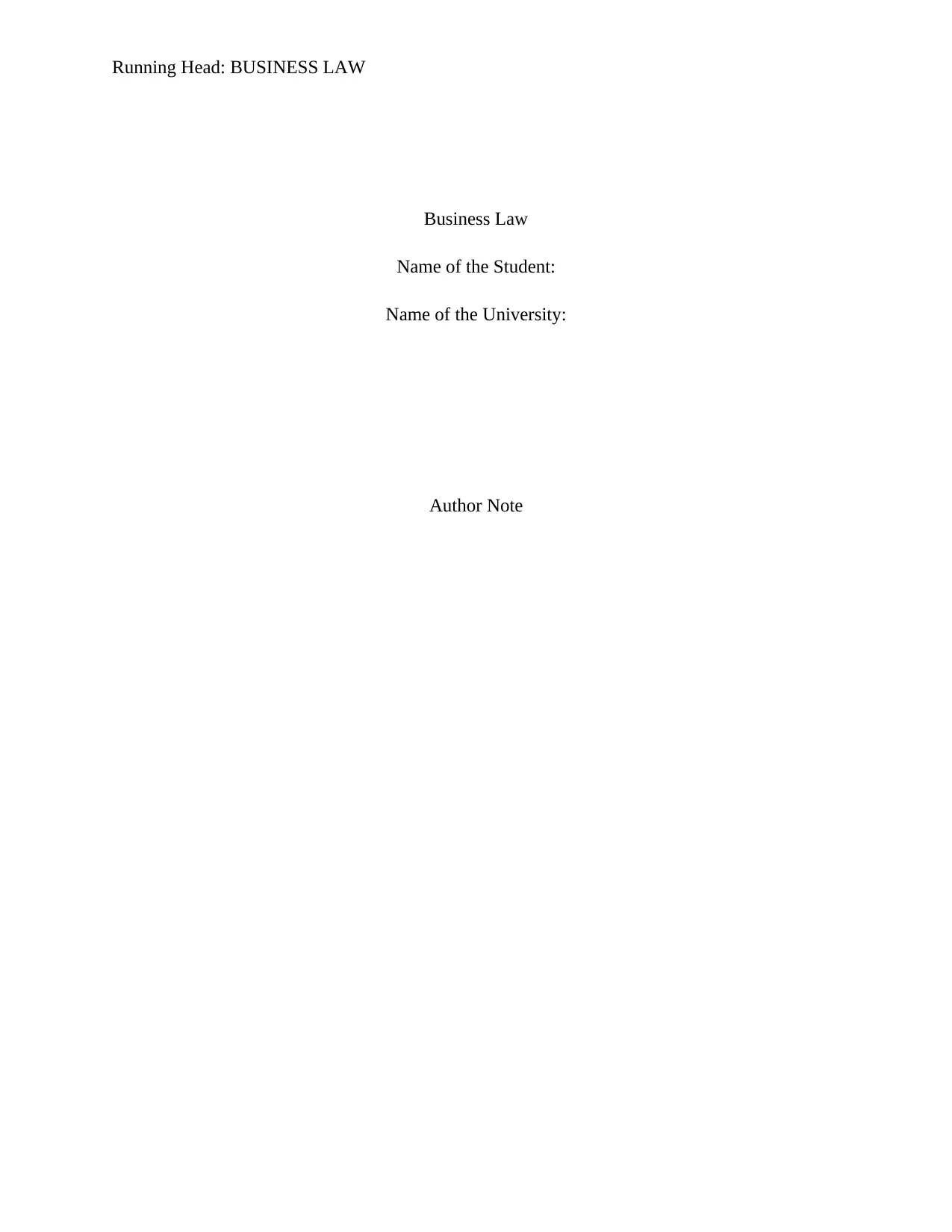
Running Head: BUSINESS LAW
Business Law
Name of the Student:
Name of the University:
Author Note
Business Law
Name of the Student:
Name of the University:
Author Note
Paraphrase This Document
Need a fresh take? Get an instant paraphrase of this document with our AI Paraphraser
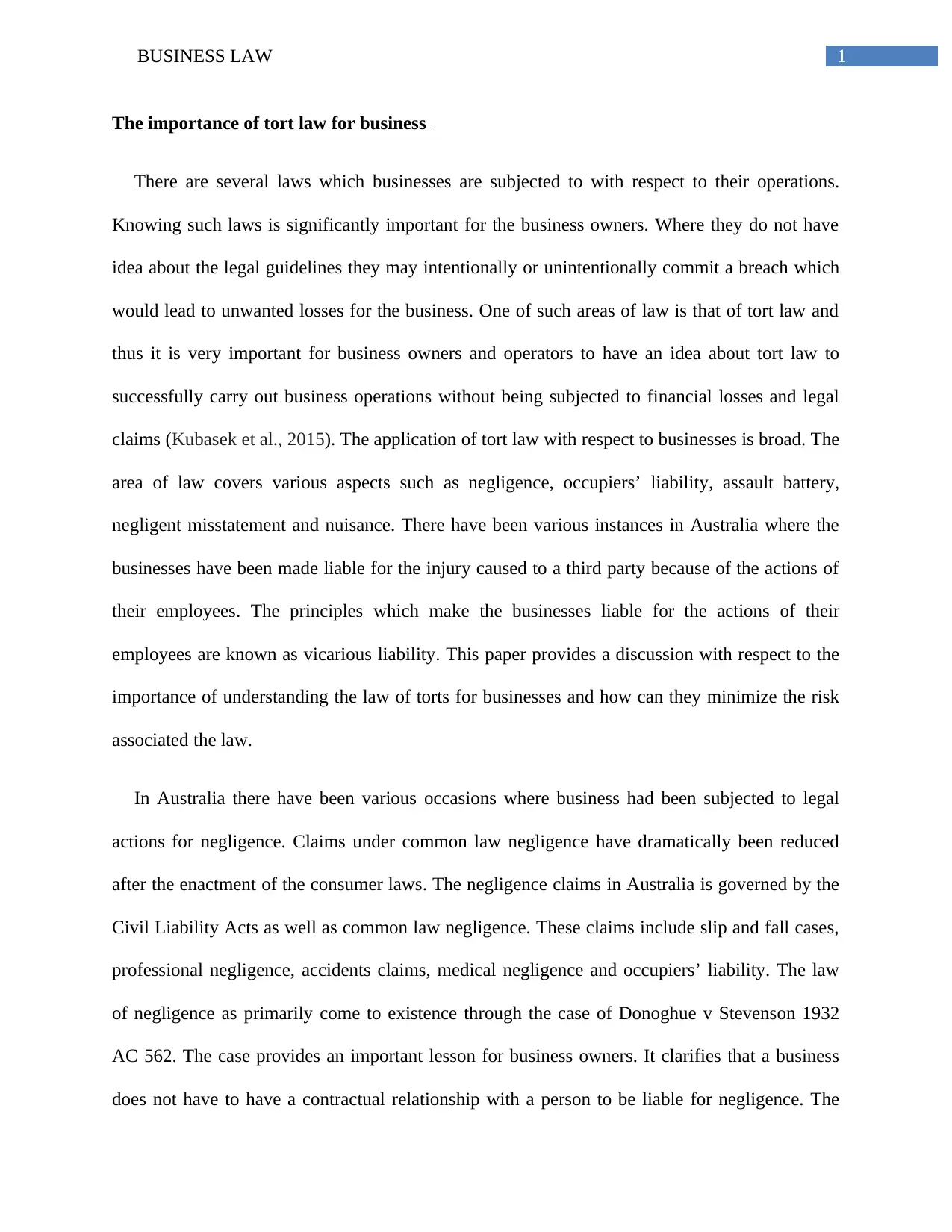
1BUSINESS LAW
The importance of tort law for business
There are several laws which businesses are subjected to with respect to their operations.
Knowing such laws is significantly important for the business owners. Where they do not have
idea about the legal guidelines they may intentionally or unintentionally commit a breach which
would lead to unwanted losses for the business. One of such areas of law is that of tort law and
thus it is very important for business owners and operators to have an idea about tort law to
successfully carry out business operations without being subjected to financial losses and legal
claims (Kubasek et al., 2015). The application of tort law with respect to businesses is broad. The
area of law covers various aspects such as negligence, occupiers’ liability, assault battery,
negligent misstatement and nuisance. There have been various instances in Australia where the
businesses have been made liable for the injury caused to a third party because of the actions of
their employees. The principles which make the businesses liable for the actions of their
employees are known as vicarious liability. This paper provides a discussion with respect to the
importance of understanding the law of torts for businesses and how can they minimize the risk
associated the law.
In Australia there have been various occasions where business had been subjected to legal
actions for negligence. Claims under common law negligence have dramatically been reduced
after the enactment of the consumer laws. The negligence claims in Australia is governed by the
Civil Liability Acts as well as common law negligence. These claims include slip and fall cases,
professional negligence, accidents claims, medical negligence and occupiers’ liability. The law
of negligence as primarily come to existence through the case of Donoghue v Stevenson 1932
AC 562. The case provides an important lesson for business owners. It clarifies that a business
does not have to have a contractual relationship with a person to be liable for negligence. The
The importance of tort law for business
There are several laws which businesses are subjected to with respect to their operations.
Knowing such laws is significantly important for the business owners. Where they do not have
idea about the legal guidelines they may intentionally or unintentionally commit a breach which
would lead to unwanted losses for the business. One of such areas of law is that of tort law and
thus it is very important for business owners and operators to have an idea about tort law to
successfully carry out business operations without being subjected to financial losses and legal
claims (Kubasek et al., 2015). The application of tort law with respect to businesses is broad. The
area of law covers various aspects such as negligence, occupiers’ liability, assault battery,
negligent misstatement and nuisance. There have been various instances in Australia where the
businesses have been made liable for the injury caused to a third party because of the actions of
their employees. The principles which make the businesses liable for the actions of their
employees are known as vicarious liability. This paper provides a discussion with respect to the
importance of understanding the law of torts for businesses and how can they minimize the risk
associated the law.
In Australia there have been various occasions where business had been subjected to legal
actions for negligence. Claims under common law negligence have dramatically been reduced
after the enactment of the consumer laws. The negligence claims in Australia is governed by the
Civil Liability Acts as well as common law negligence. These claims include slip and fall cases,
professional negligence, accidents claims, medical negligence and occupiers’ liability. The law
of negligence as primarily come to existence through the case of Donoghue v Stevenson 1932
AC 562. The case provides an important lesson for business owners. It clarifies that a business
does not have to have a contractual relationship with a person to be liable for negligence. The
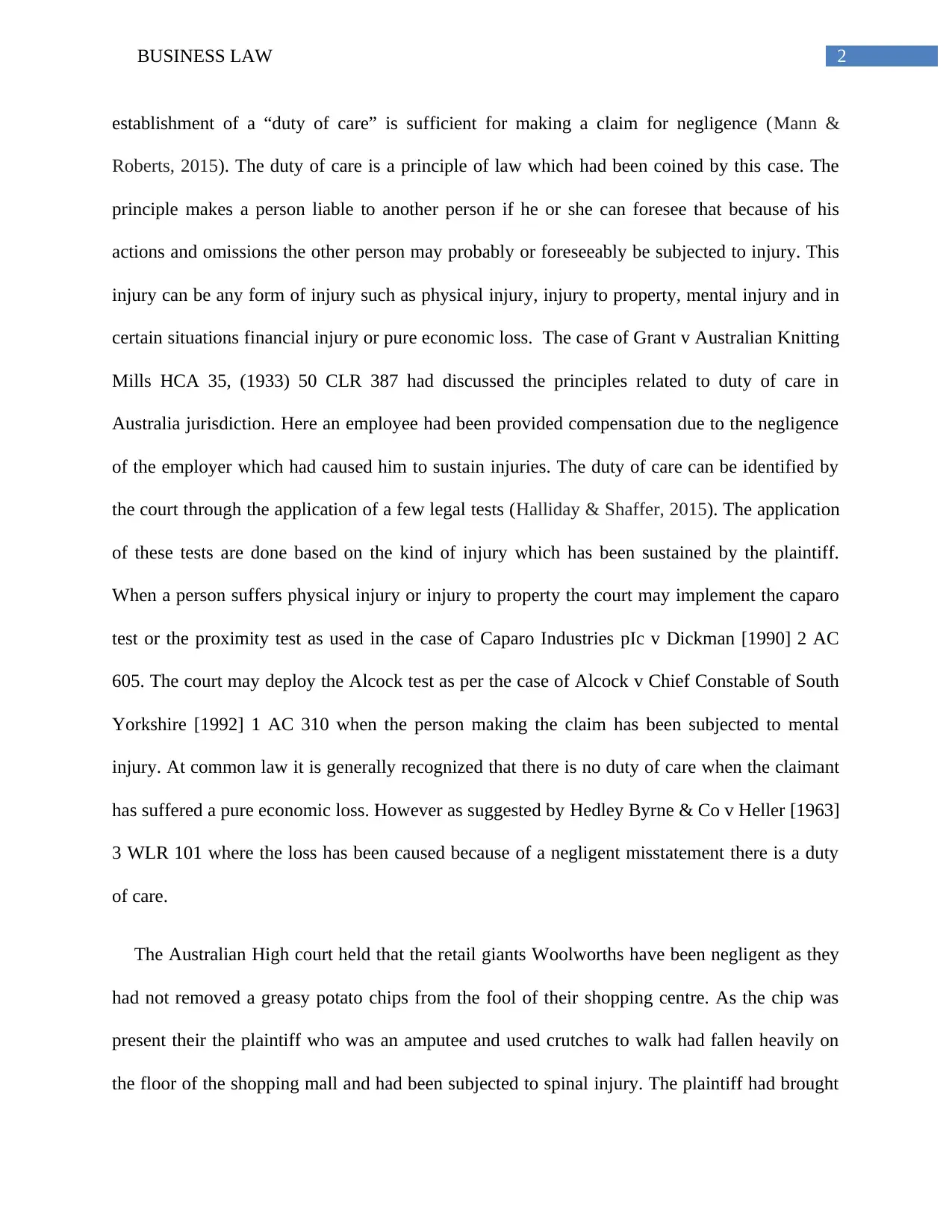
2BUSINESS LAW
establishment of a “duty of care” is sufficient for making a claim for negligence (Mann &
Roberts, 2015). The duty of care is a principle of law which had been coined by this case. The
principle makes a person liable to another person if he or she can foresee that because of his
actions and omissions the other person may probably or foreseeably be subjected to injury. This
injury can be any form of injury such as physical injury, injury to property, mental injury and in
certain situations financial injury or pure economic loss. The case of Grant v Australian Knitting
Mills HCA 35, (1933) 50 CLR 387 had discussed the principles related to duty of care in
Australia jurisdiction. Here an employee had been provided compensation due to the negligence
of the employer which had caused him to sustain injuries. The duty of care can be identified by
the court through the application of a few legal tests (Halliday & Shaffer, 2015). The application
of these tests are done based on the kind of injury which has been sustained by the plaintiff.
When a person suffers physical injury or injury to property the court may implement the caparo
test or the proximity test as used in the case of Caparo Industries pIc v Dickman [1990] 2 AC
605. The court may deploy the Alcock test as per the case of Alcock v Chief Constable of South
Yorkshire [1992] 1 AC 310 when the person making the claim has been subjected to mental
injury. At common law it is generally recognized that there is no duty of care when the claimant
has suffered a pure economic loss. However as suggested by Hedley Byrne & Co v Heller [1963]
3 WLR 101 where the loss has been caused because of a negligent misstatement there is a duty
of care.
The Australian High court held that the retail giants Woolworths have been negligent as they
had not removed a greasy potato chips from the fool of their shopping centre. As the chip was
present their the plaintiff who was an amputee and used crutches to walk had fallen heavily on
the floor of the shopping mall and had been subjected to spinal injury. The plaintiff had brought
establishment of a “duty of care” is sufficient for making a claim for negligence (Mann &
Roberts, 2015). The duty of care is a principle of law which had been coined by this case. The
principle makes a person liable to another person if he or she can foresee that because of his
actions and omissions the other person may probably or foreseeably be subjected to injury. This
injury can be any form of injury such as physical injury, injury to property, mental injury and in
certain situations financial injury or pure economic loss. The case of Grant v Australian Knitting
Mills HCA 35, (1933) 50 CLR 387 had discussed the principles related to duty of care in
Australia jurisdiction. Here an employee had been provided compensation due to the negligence
of the employer which had caused him to sustain injuries. The duty of care can be identified by
the court through the application of a few legal tests (Halliday & Shaffer, 2015). The application
of these tests are done based on the kind of injury which has been sustained by the plaintiff.
When a person suffers physical injury or injury to property the court may implement the caparo
test or the proximity test as used in the case of Caparo Industries pIc v Dickman [1990] 2 AC
605. The court may deploy the Alcock test as per the case of Alcock v Chief Constable of South
Yorkshire [1992] 1 AC 310 when the person making the claim has been subjected to mental
injury. At common law it is generally recognized that there is no duty of care when the claimant
has suffered a pure economic loss. However as suggested by Hedley Byrne & Co v Heller [1963]
3 WLR 101 where the loss has been caused because of a negligent misstatement there is a duty
of care.
The Australian High court held that the retail giants Woolworths have been negligent as they
had not removed a greasy potato chips from the fool of their shopping centre. As the chip was
present their the plaintiff who was an amputee and used crutches to walk had fallen heavily on
the floor of the shopping mall and had been subjected to spinal injury. The plaintiff had brought
⊘ This is a preview!⊘
Do you want full access?
Subscribe today to unlock all pages.

Trusted by 1+ million students worldwide
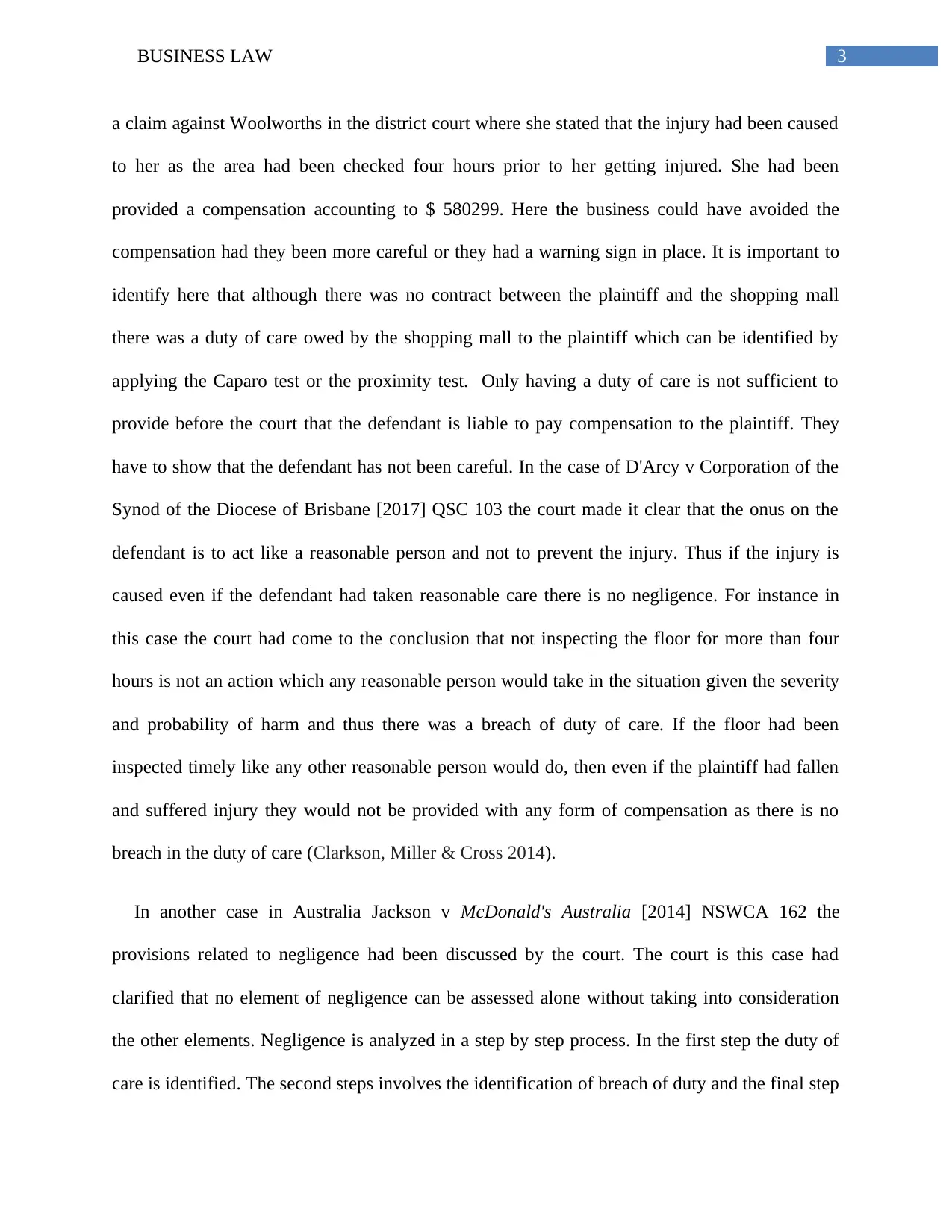
3BUSINESS LAW
a claim against Woolworths in the district court where she stated that the injury had been caused
to her as the area had been checked four hours prior to her getting injured. She had been
provided a compensation accounting to $ 580299. Here the business could have avoided the
compensation had they been more careful or they had a warning sign in place. It is important to
identify here that although there was no contract between the plaintiff and the shopping mall
there was a duty of care owed by the shopping mall to the plaintiff which can be identified by
applying the Caparo test or the proximity test. Only having a duty of care is not sufficient to
provide before the court that the defendant is liable to pay compensation to the plaintiff. They
have to show that the defendant has not been careful. In the case of D'Arcy v Corporation of the
Synod of the Diocese of Brisbane [2017] QSC 103 the court made it clear that the onus on the
defendant is to act like a reasonable person and not to prevent the injury. Thus if the injury is
caused even if the defendant had taken reasonable care there is no negligence. For instance in
this case the court had come to the conclusion that not inspecting the floor for more than four
hours is not an action which any reasonable person would take in the situation given the severity
and probability of harm and thus there was a breach of duty of care. If the floor had been
inspected timely like any other reasonable person would do, then even if the plaintiff had fallen
and suffered injury they would not be provided with any form of compensation as there is no
breach in the duty of care (Clarkson, Miller & Cross 2014).
In another case in Australia Jackson v McDonald's Australia [2014] NSWCA 162 the
provisions related to negligence had been discussed by the court. The court is this case had
clarified that no element of negligence can be assessed alone without taking into consideration
the other elements. Negligence is analyzed in a step by step process. In the first step the duty of
care is identified. The second steps involves the identification of breach of duty and the final step
a claim against Woolworths in the district court where she stated that the injury had been caused
to her as the area had been checked four hours prior to her getting injured. She had been
provided a compensation accounting to $ 580299. Here the business could have avoided the
compensation had they been more careful or they had a warning sign in place. It is important to
identify here that although there was no contract between the plaintiff and the shopping mall
there was a duty of care owed by the shopping mall to the plaintiff which can be identified by
applying the Caparo test or the proximity test. Only having a duty of care is not sufficient to
provide before the court that the defendant is liable to pay compensation to the plaintiff. They
have to show that the defendant has not been careful. In the case of D'Arcy v Corporation of the
Synod of the Diocese of Brisbane [2017] QSC 103 the court made it clear that the onus on the
defendant is to act like a reasonable person and not to prevent the injury. Thus if the injury is
caused even if the defendant had taken reasonable care there is no negligence. For instance in
this case the court had come to the conclusion that not inspecting the floor for more than four
hours is not an action which any reasonable person would take in the situation given the severity
and probability of harm and thus there was a breach of duty of care. If the floor had been
inspected timely like any other reasonable person would do, then even if the plaintiff had fallen
and suffered injury they would not be provided with any form of compensation as there is no
breach in the duty of care (Clarkson, Miller & Cross 2014).
In another case in Australia Jackson v McDonald's Australia [2014] NSWCA 162 the
provisions related to negligence had been discussed by the court. The court is this case had
clarified that no element of negligence can be assessed alone without taking into consideration
the other elements. Negligence is analyzed in a step by step process. In the first step the duty of
care is identified. The second steps involves the identification of breach of duty and the final step
Paraphrase This Document
Need a fresh take? Get an instant paraphrase of this document with our AI Paraphraser
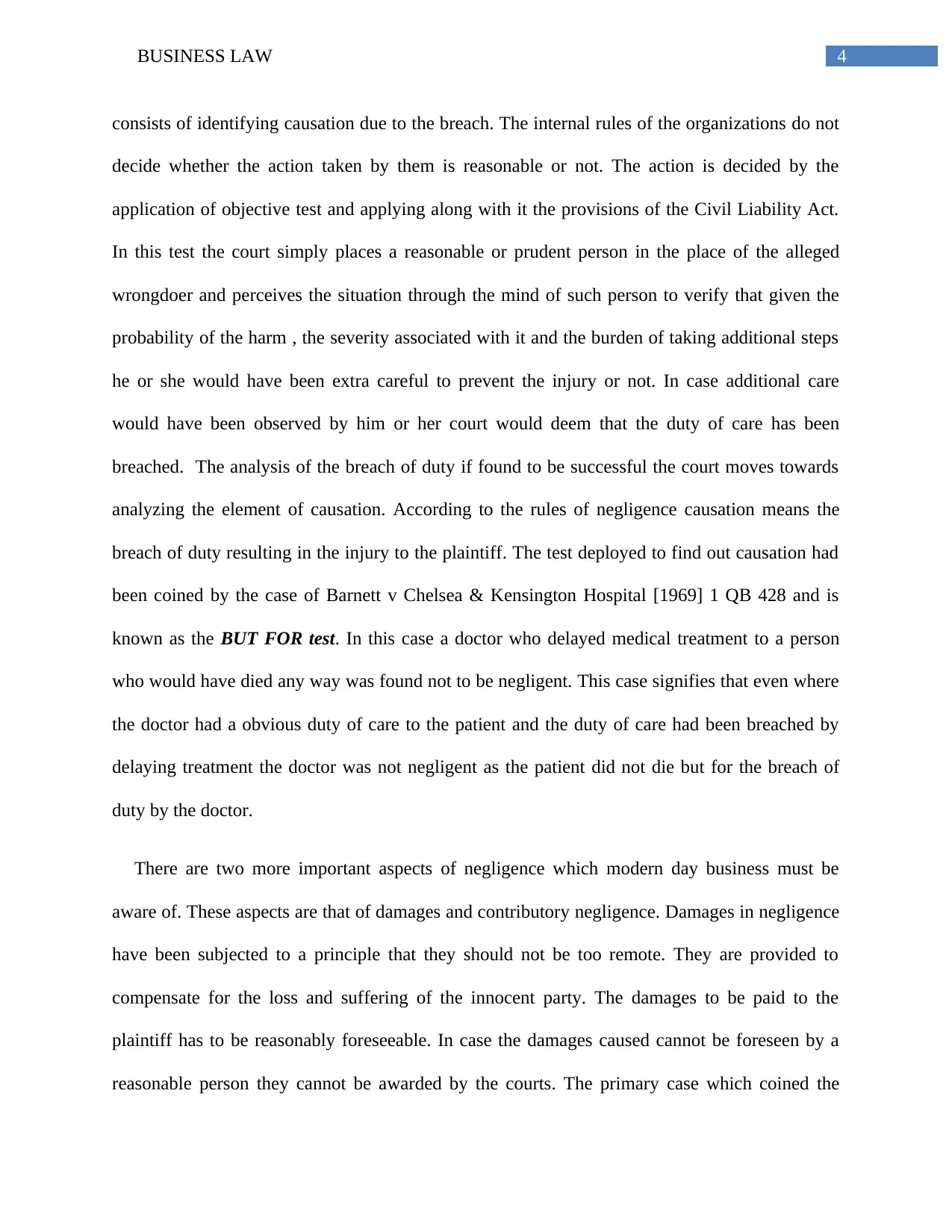
4BUSINESS LAW
consists of identifying causation due to the breach. The internal rules of the organizations do not
decide whether the action taken by them is reasonable or not. The action is decided by the
application of objective test and applying along with it the provisions of the Civil Liability Act.
In this test the court simply places a reasonable or prudent person in the place of the alleged
wrongdoer and perceives the situation through the mind of such person to verify that given the
probability of the harm , the severity associated with it and the burden of taking additional steps
he or she would have been extra careful to prevent the injury or not. In case additional care
would have been observed by him or her court would deem that the duty of care has been
breached. The analysis of the breach of duty if found to be successful the court moves towards
analyzing the element of causation. According to the rules of negligence causation means the
breach of duty resulting in the injury to the plaintiff. The test deployed to find out causation had
been coined by the case of Barnett v Chelsea & Kensington Hospital [1969] 1 QB 428 and is
known as the BUT FOR test. In this case a doctor who delayed medical treatment to a person
who would have died any way was found not to be negligent. This case signifies that even where
the doctor had a obvious duty of care to the patient and the duty of care had been breached by
delaying treatment the doctor was not negligent as the patient did not die but for the breach of
duty by the doctor.
There are two more important aspects of negligence which modern day business must be
aware of. These aspects are that of damages and contributory negligence. Damages in negligence
have been subjected to a principle that they should not be too remote. They are provided to
compensate for the loss and suffering of the innocent party. The damages to be paid to the
plaintiff has to be reasonably foreseeable. In case the damages caused cannot be foreseen by a
reasonable person they cannot be awarded by the courts. The primary case which coined the
consists of identifying causation due to the breach. The internal rules of the organizations do not
decide whether the action taken by them is reasonable or not. The action is decided by the
application of objective test and applying along with it the provisions of the Civil Liability Act.
In this test the court simply places a reasonable or prudent person in the place of the alleged
wrongdoer and perceives the situation through the mind of such person to verify that given the
probability of the harm , the severity associated with it and the burden of taking additional steps
he or she would have been extra careful to prevent the injury or not. In case additional care
would have been observed by him or her court would deem that the duty of care has been
breached. The analysis of the breach of duty if found to be successful the court moves towards
analyzing the element of causation. According to the rules of negligence causation means the
breach of duty resulting in the injury to the plaintiff. The test deployed to find out causation had
been coined by the case of Barnett v Chelsea & Kensington Hospital [1969] 1 QB 428 and is
known as the BUT FOR test. In this case a doctor who delayed medical treatment to a person
who would have died any way was found not to be negligent. This case signifies that even where
the doctor had a obvious duty of care to the patient and the duty of care had been breached by
delaying treatment the doctor was not negligent as the patient did not die but for the breach of
duty by the doctor.
There are two more important aspects of negligence which modern day business must be
aware of. These aspects are that of damages and contributory negligence. Damages in negligence
have been subjected to a principle that they should not be too remote. They are provided to
compensate for the loss and suffering of the innocent party. The damages to be paid to the
plaintiff has to be reasonably foreseeable. In case the damages caused cannot be foreseen by a
reasonable person they cannot be awarded by the courts. The primary case which coined the
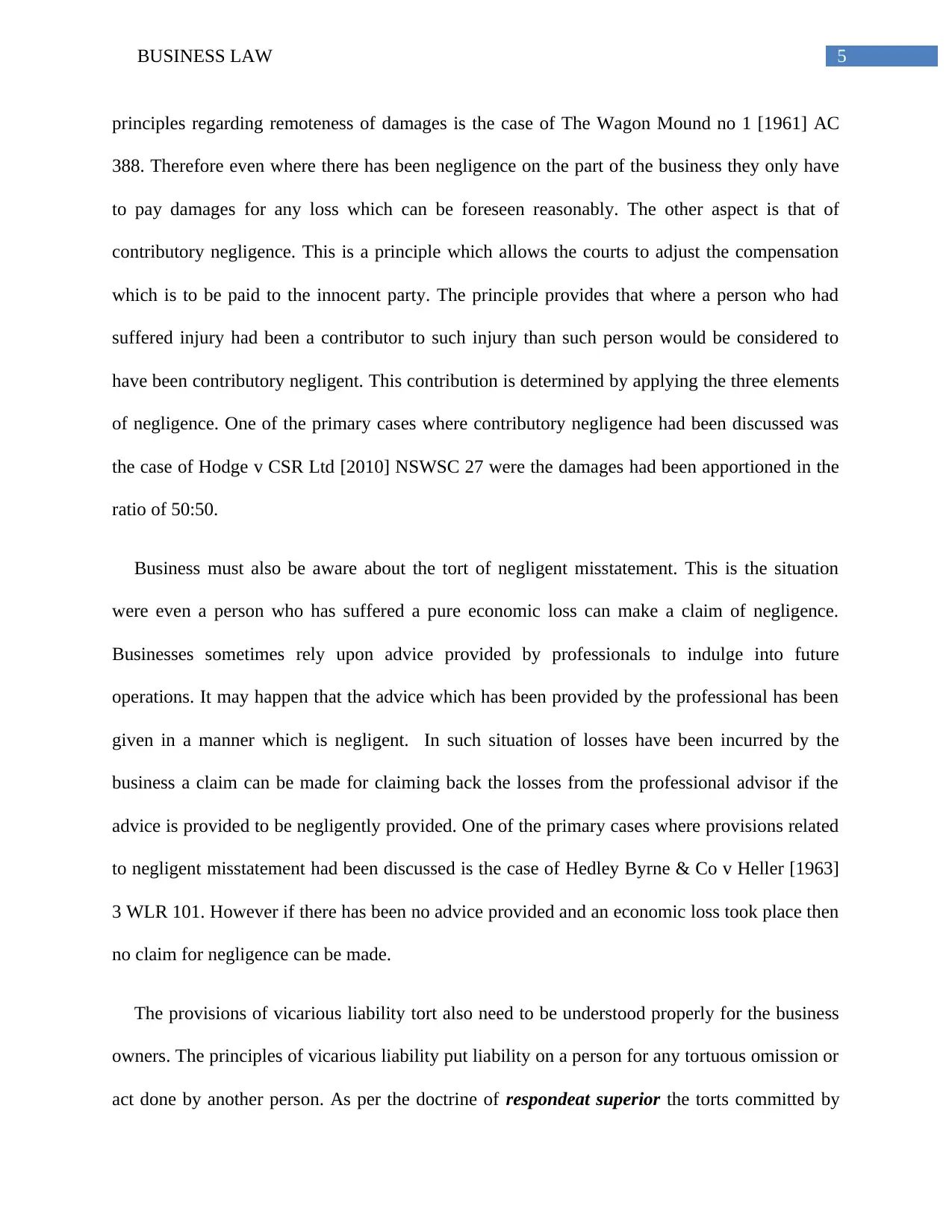
5BUSINESS LAW
principles regarding remoteness of damages is the case of The Wagon Mound no 1 [1961] AC
388. Therefore even where there has been negligence on the part of the business they only have
to pay damages for any loss which can be foreseen reasonably. The other aspect is that of
contributory negligence. This is a principle which allows the courts to adjust the compensation
which is to be paid to the innocent party. The principle provides that where a person who had
suffered injury had been a contributor to such injury than such person would be considered to
have been contributory negligent. This contribution is determined by applying the three elements
of negligence. One of the primary cases where contributory negligence had been discussed was
the case of Hodge v CSR Ltd [2010] NSWSC 27 were the damages had been apportioned in the
ratio of 50:50.
Business must also be aware about the tort of negligent misstatement. This is the situation
were even a person who has suffered a pure economic loss can make a claim of negligence.
Businesses sometimes rely upon advice provided by professionals to indulge into future
operations. It may happen that the advice which has been provided by the professional has been
given in a manner which is negligent. In such situation of losses have been incurred by the
business a claim can be made for claiming back the losses from the professional advisor if the
advice is provided to be negligently provided. One of the primary cases where provisions related
to negligent misstatement had been discussed is the case of Hedley Byrne & Co v Heller [1963]
3 WLR 101. However if there has been no advice provided and an economic loss took place then
no claim for negligence can be made.
The provisions of vicarious liability tort also need to be understood properly for the business
owners. The principles of vicarious liability put liability on a person for any tortuous omission or
act done by another person. As per the doctrine of respondeat superior the torts committed by
principles regarding remoteness of damages is the case of The Wagon Mound no 1 [1961] AC
388. Therefore even where there has been negligence on the part of the business they only have
to pay damages for any loss which can be foreseen reasonably. The other aspect is that of
contributory negligence. This is a principle which allows the courts to adjust the compensation
which is to be paid to the innocent party. The principle provides that where a person who had
suffered injury had been a contributor to such injury than such person would be considered to
have been contributory negligent. This contribution is determined by applying the three elements
of negligence. One of the primary cases where contributory negligence had been discussed was
the case of Hodge v CSR Ltd [2010] NSWSC 27 were the damages had been apportioned in the
ratio of 50:50.
Business must also be aware about the tort of negligent misstatement. This is the situation
were even a person who has suffered a pure economic loss can make a claim of negligence.
Businesses sometimes rely upon advice provided by professionals to indulge into future
operations. It may happen that the advice which has been provided by the professional has been
given in a manner which is negligent. In such situation of losses have been incurred by the
business a claim can be made for claiming back the losses from the professional advisor if the
advice is provided to be negligently provided. One of the primary cases where provisions related
to negligent misstatement had been discussed is the case of Hedley Byrne & Co v Heller [1963]
3 WLR 101. However if there has been no advice provided and an economic loss took place then
no claim for negligence can be made.
The provisions of vicarious liability tort also need to be understood properly for the business
owners. The principles of vicarious liability put liability on a person for any tortuous omission or
act done by another person. As per the doctrine of respondeat superior the torts committed by
⊘ This is a preview!⊘
Do you want full access?
Subscribe today to unlock all pages.

Trusted by 1+ million students worldwide
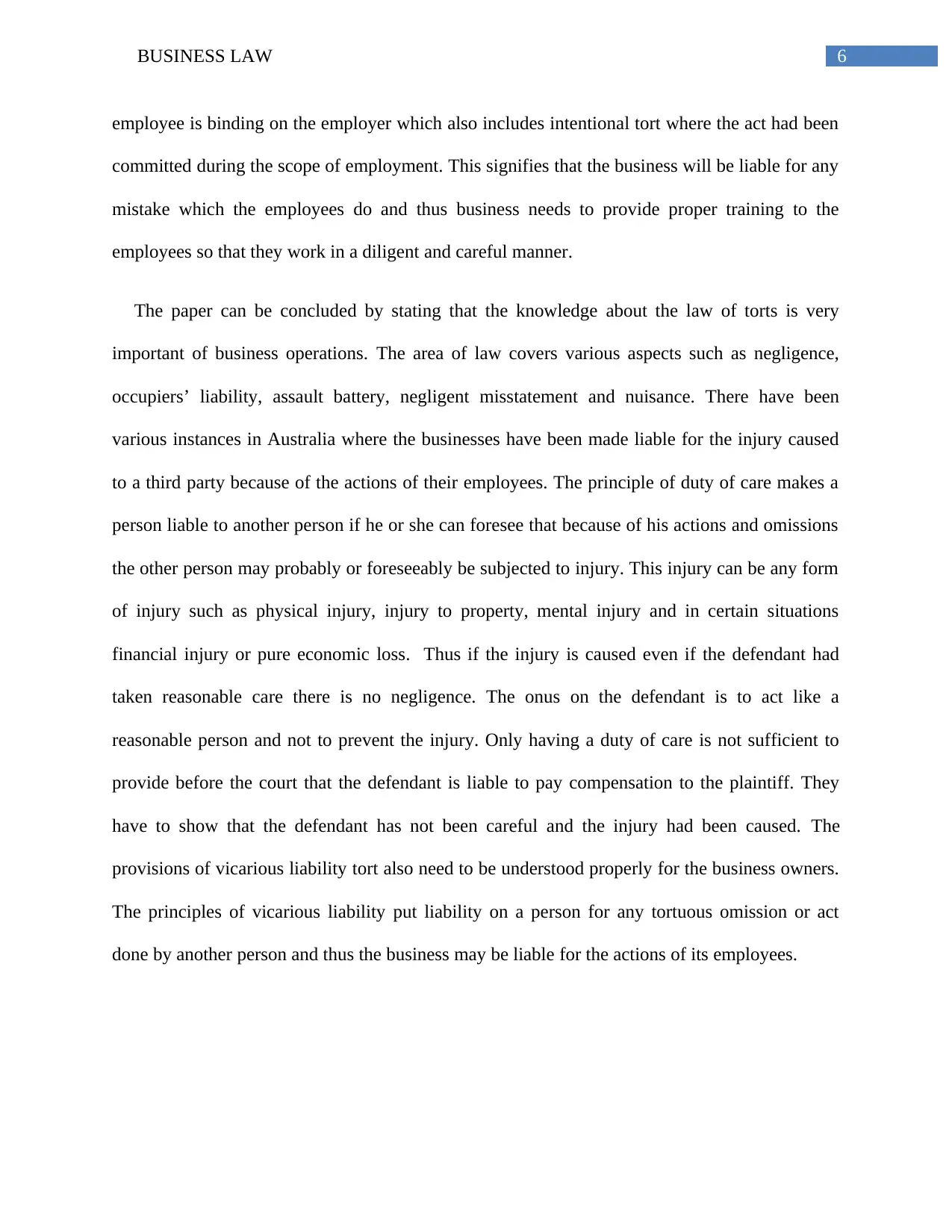
6BUSINESS LAW
employee is binding on the employer which also includes intentional tort where the act had been
committed during the scope of employment. This signifies that the business will be liable for any
mistake which the employees do and thus business needs to provide proper training to the
employees so that they work in a diligent and careful manner.
The paper can be concluded by stating that the knowledge about the law of torts is very
important of business operations. The area of law covers various aspects such as negligence,
occupiers’ liability, assault battery, negligent misstatement and nuisance. There have been
various instances in Australia where the businesses have been made liable for the injury caused
to a third party because of the actions of their employees. The principle of duty of care makes a
person liable to another person if he or she can foresee that because of his actions and omissions
the other person may probably or foreseeably be subjected to injury. This injury can be any form
of injury such as physical injury, injury to property, mental injury and in certain situations
financial injury or pure economic loss. Thus if the injury is caused even if the defendant had
taken reasonable care there is no negligence. The onus on the defendant is to act like a
reasonable person and not to prevent the injury. Only having a duty of care is not sufficient to
provide before the court that the defendant is liable to pay compensation to the plaintiff. They
have to show that the defendant has not been careful and the injury had been caused. The
provisions of vicarious liability tort also need to be understood properly for the business owners.
The principles of vicarious liability put liability on a person for any tortuous omission or act
done by another person and thus the business may be liable for the actions of its employees.
employee is binding on the employer which also includes intentional tort where the act had been
committed during the scope of employment. This signifies that the business will be liable for any
mistake which the employees do and thus business needs to provide proper training to the
employees so that they work in a diligent and careful manner.
The paper can be concluded by stating that the knowledge about the law of torts is very
important of business operations. The area of law covers various aspects such as negligence,
occupiers’ liability, assault battery, negligent misstatement and nuisance. There have been
various instances in Australia where the businesses have been made liable for the injury caused
to a third party because of the actions of their employees. The principle of duty of care makes a
person liable to another person if he or she can foresee that because of his actions and omissions
the other person may probably or foreseeably be subjected to injury. This injury can be any form
of injury such as physical injury, injury to property, mental injury and in certain situations
financial injury or pure economic loss. Thus if the injury is caused even if the defendant had
taken reasonable care there is no negligence. The onus on the defendant is to act like a
reasonable person and not to prevent the injury. Only having a duty of care is not sufficient to
provide before the court that the defendant is liable to pay compensation to the plaintiff. They
have to show that the defendant has not been careful and the injury had been caused. The
provisions of vicarious liability tort also need to be understood properly for the business owners.
The principles of vicarious liability put liability on a person for any tortuous omission or act
done by another person and thus the business may be liable for the actions of its employees.
Paraphrase This Document
Need a fresh take? Get an instant paraphrase of this document with our AI Paraphraser
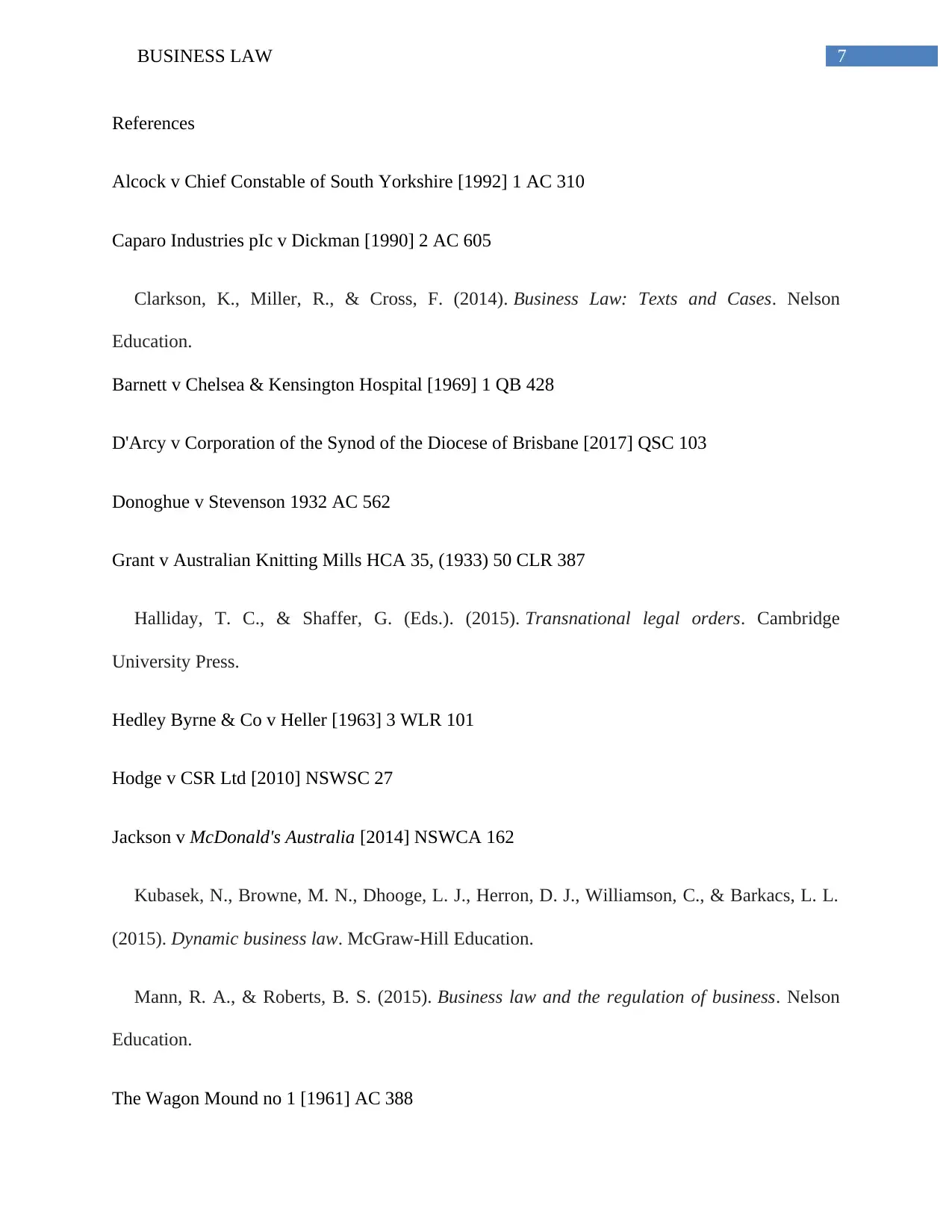
7BUSINESS LAW
References
Alcock v Chief Constable of South Yorkshire [1992] 1 AC 310
Caparo Industries pIc v Dickman [1990] 2 AC 605
Clarkson, K., Miller, R., & Cross, F. (2014). Business Law: Texts and Cases. Nelson
Education.
Barnett v Chelsea & Kensington Hospital [1969] 1 QB 428
D'Arcy v Corporation of the Synod of the Diocese of Brisbane [2017] QSC 103
Donoghue v Stevenson 1932 AC 562
Grant v Australian Knitting Mills HCA 35, (1933) 50 CLR 387
Halliday, T. C., & Shaffer, G. (Eds.). (2015). Transnational legal orders. Cambridge
University Press.
Hedley Byrne & Co v Heller [1963] 3 WLR 101
Hodge v CSR Ltd [2010] NSWSC 27
Jackson v McDonald's Australia [2014] NSWCA 162
Kubasek, N., Browne, M. N., Dhooge, L. J., Herron, D. J., Williamson, C., & Barkacs, L. L.
(2015). Dynamic business law. McGraw-Hill Education.
Mann, R. A., & Roberts, B. S. (2015). Business law and the regulation of business. Nelson
Education.
The Wagon Mound no 1 [1961] AC 388
References
Alcock v Chief Constable of South Yorkshire [1992] 1 AC 310
Caparo Industries pIc v Dickman [1990] 2 AC 605
Clarkson, K., Miller, R., & Cross, F. (2014). Business Law: Texts and Cases. Nelson
Education.
Barnett v Chelsea & Kensington Hospital [1969] 1 QB 428
D'Arcy v Corporation of the Synod of the Diocese of Brisbane [2017] QSC 103
Donoghue v Stevenson 1932 AC 562
Grant v Australian Knitting Mills HCA 35, (1933) 50 CLR 387
Halliday, T. C., & Shaffer, G. (Eds.). (2015). Transnational legal orders. Cambridge
University Press.
Hedley Byrne & Co v Heller [1963] 3 WLR 101
Hodge v CSR Ltd [2010] NSWSC 27
Jackson v McDonald's Australia [2014] NSWCA 162
Kubasek, N., Browne, M. N., Dhooge, L. J., Herron, D. J., Williamson, C., & Barkacs, L. L.
(2015). Dynamic business law. McGraw-Hill Education.
Mann, R. A., & Roberts, B. S. (2015). Business law and the regulation of business. Nelson
Education.
The Wagon Mound no 1 [1961] AC 388
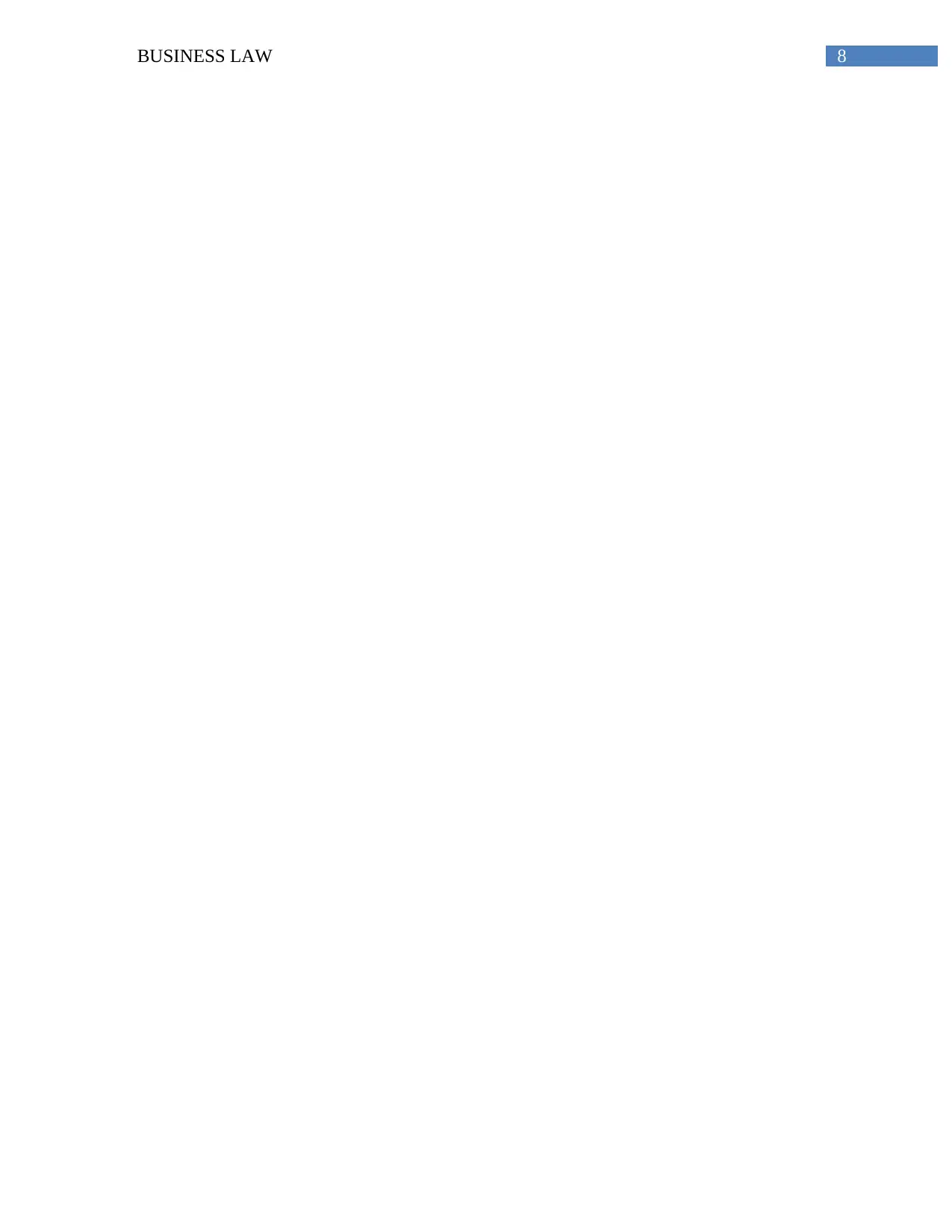
8BUSINESS LAW
⊘ This is a preview!⊘
Do you want full access?
Subscribe today to unlock all pages.

Trusted by 1+ million students worldwide
1 out of 9
Related Documents
Your All-in-One AI-Powered Toolkit for Academic Success.
+13062052269
info@desklib.com
Available 24*7 on WhatsApp / Email
![[object Object]](/_next/static/media/star-bottom.7253800d.svg)
Unlock your academic potential
Copyright © 2020–2025 A2Z Services. All Rights Reserved. Developed and managed by ZUCOL.





